What may start as an adventure or play may lead to a painful injury, causing discomfort and accentuated pain in the chilly winters. Physical injuries are likely to occur even from carrying out small tasks, mostly when you aren’t prepared to deal with one. In winters, the common body parts where everyone experiences pain are the head, neck, shoulder, back, knees, and joints, especially in places that stay cool, even during summers. It may be a big challenge to keep healthy all year round in these places.
But fortunately, obviating winter injuries is viable, and you can relish the season without experiencing pain and inflexibility in your body. Scroll through to understand the various common winter injuries and the ways by which you can avoid them and sustain good health.
Frostbites
Frostbite is a physical state resulting from freezing temperature that is inimical and damages patches of your skin and tissues underneath. The skin areas that lie outside unprotected in extreme weather get red or sore; this is known as frostnip, an initial stage of frostbite. The tip of the nose, feet, hands, and cheeks are at higher risk. To protect these vulnerable points, you must mask up, wear warm socks and leather gloves before stepping outside. These bulwarks will save you from potential injuries.
The symptom of frostbites depends on how deep it has affected the skin. There are three stages of frostbite; the early stage of frostbite concerns the epidermis causing the skin to turn pale yellow or white, followed by numbness. It may sting and burn, but the frostbite worsens with more advanced stages. In the later stages, the skin becomes hard, the skin colour darkens briskly, turning black. A liquid-filled blister appears twelve to thirty-six hours after rewarming the skin, and your muscles may pause functioning.
Hypothermia
Prolonged exposure to the frigid climate jeopardises the body temperature, pushing it to drop quickly. When the stability between the body’s heat generation and heat loss inclines toward heat loss for a long duration, hypothermia can occur. Mountaineers eschew hypothermia by guarding themselves with specialised, advanced gear developed for that gusty, cold weather. Nevertheless, a moderate climate can also cause hypothermia depending on age, body mass, overall fitness, and the duration of time a person is exposed to freezing temperature. For instance, newborns and babies sleeping in cold places are at risk of hypothermia.
When exposed to freezing temperature, 90% of heat loss occurs through your skin, the rest from the lungs. Typically, heat loss happens through radiation and accelerates when exposed to breeze or moisture. Suppose you have been exposed to cold temperatures due to submerging in water. In that case, heat loss can occur 25 times quicker than being exposed to the same room temperature and pressure. The brain’s temperature control centres lift the body temperature by activating the heat and cooling the body. When the body is exposed to cold temperatures, quivering is a defensive response to generate heat through muscle movements. As hypothermia advances, you may stop shivering, and in severe cases, the body temperature may drop below 82 degrees Fahrenheit. You must proceed gently to a warm spot, remove any wet clothes, and reheat yourself.
The chain of ORTHOCURE Clinics is India‘s 1st Chain of Specialty Clinics for Orthopaedic Problems. We provide a cohesive solution for orthopaedic problems utilising the experience and expertise of Orthopedists, Physiotherapists, Chiropractors, Fitness and Foot Orthotics experts who work in conjunction using a unique four-point approach towards holistic wellbeing. We begin with the most suitable diagnostic tests, the emphasis on helping with immediate pain relief, followed by a holistic treatment process (focusing on the root causes of pain and discomfort) and preventive care to avoid cases of relapse and recurrence. We provide knee pain treatment, neck treatment, and back pain treatment to the ones suffering from common winter injuries.





